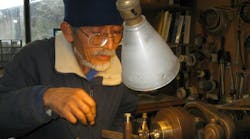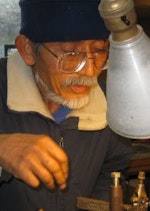What you’ll learn:
- Practical knowledge not covered by your BSEE.
- Ways to gain practical knowledge and experience.
I managed to become a medical electronics engineer despite never attending engineering school. I did it the hard way—learning on my own. A BS degree in physics helped, but Maxwell's equations didn’t teach me to design circuits.
I started tinkering with electronics at age 10, repairing vacuum-tube radios. I gradually learned over decades by reading books and magazines, and by experimenting. What I gained from this slow method was a grasp of the practical aspects of electronics, the things not taught in engineering school.
I once worked with an engineer, with a fresh BSEE. He showed me a differential amplifier design that got an A grade from his teacher. It had dual coupling capacitors on the inputs. The problem was that the low-frequency common-mode rejection was terrible unless the capacitors were ideally matched.
Real capacitors have tolerances of 5%; 1% for expensive ones. This illustrates the difference between theoretical circuit design and real life. What’s the difference between a ceramic capacitor and a polypropylene capacitor? Can you use an electrolytic capacitor with zero bias voltage to pass AC? The answers are probably not found in school.
Another engineer designed an op-amp circuit in non-inverting mode with a coupling capacitor wired directly to the non-inverting input. I told him the input had to have a resistive DC path to ground. He didn't believe me. He was unaware of bias current in real amplifiers and RC low-frequency roll-off. I knew a resistor was needed because grid leak resistors were part of the capacitive coupling in vacuum-tube amplifiers.
A high-end electronic piano used conductive rubber contacts for the keys, with pull-up resistors. They quit working when the rubber aged. I modified the circuit with higher resistance pull-ups.
More Examples of Real-Life Electronics
If you use a toggle switch designed for 120 V AC to switch 3.3-V logic signals, it will eventually fail because the silver contacts will oxidize, or the lubricating grease will harden and the low voltage will not break through the insulating film. Gold contacts are needed.
An expensive analytical instrument required frequent maintenance because a low-resistance calibration potentiometer was used as a rheostat, passing current. The contact resistance of the slider would change with oxidation, requiring tweaking the pot to break through the film. Designing the circuit to use the pot in a three-terminal potentiometer mode would have been better.
Resistors have voltage ratings. This becomes important with high voltages and high resistance. Wire-wound resistors may have significant inductance.
Ohm's Law is an approximation; real-life resistance varies with current, especially for semiconductors and incandescent bulbs. Even resistors have temperature coefficients—the resistance varies with current.
Transistors have wide variations in beta among samples. Just because a prototype works doesn’t mean that production units will all work. Ensure that the base drive current is sufficient for minimum beta. However, overdriving may result in significantly increased turn-off delay.
Thousands of connectors are available. Choosing a suitable one can be complicated when taking into account contact material, mating cycle life, latching mechanism, and strain relief. Reliable crimp connections require proper tools and exacting procedures.
I learned a lot about reliability by repairing thousands of devices, from clocks to cars to computers. What I found was that most failures weren’t accidents, but inherent in the design. I wasn’t content to merely replace defective parts. I wound up sawing things apart to find the precise point of failure.
For example, transformers, relay coils, and solenoids often failed because the terminal wires had no slack and would eventually break. Electrolytic capacitors would fail prematurely by being placed next to high-wattage resistors.
Some Suggestions for Post-Degree Learning
A lot of practical information can be gleaned from component datasheets. Most of these are extremely detailed, with typical applications to provide design guidance. For example, the surge rating of rectifiers is important because power-supply filter capacitors present a heavy momentary load on startup.
Practice repair of electronic devices. Learn techniques for tracing signals, testing components, and working with printed circuit boards. Learn how to solder and desolder surface-mount parts without expensive equipment.
Study catalogs to become aware of the vast field of available components and their characteristics.
Strive to make your designs simple, fault-tolerant, and elegant. Any novice can design a circuit with five trim pots. An expert can reduce it to one.
Broaden your field of view by studying other disciplines, such as strength of materials and biology. I learned a lot about flaws in bridge and building design from civil engineer Stephen Ressler's excellent DVD titled Epic Engineering Failures. Biology gives examples of fault-tolerant systems. If an insect chews the central vein on a leaf, alternate paths keep the leaf functioning. I like to watch Mentour Pilot video analyses of airline crashes, such as the Boeing 737 Max.
Keep up-to-date with the rapidly changing field by reading magazines, such as Electronic Design.
Try to associate with experienced engineers. Read works by Lou Frenzel and Bob Pease.


